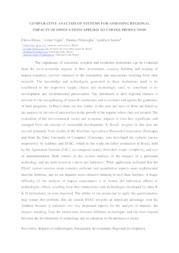Comparative analysis of systems for assessing regional impacts of innovations applied to coffee production.
Comparative analysis of systems for assessing regional impacts of innovations applied to coffee production.
Author(s): BLISKA, F.; VEGRO, C.; FRONZAGLIA, T.; SANTOS, J. de F.
Summary: The importance of education, research and extension institutions can be evaluated from the socio-economic impacts of their investments, capacity building and training of human resources, services rendered to the community and innovations resulting from their research. The knowledge and technologies generated in these institutions need to be transferred to the respective supply chains and increasingly used, to contribute in its development and environmental preservation. The dimension of their regional impacts is relevant to the strengthening of research institutions and to evaluate and update the guidelines of their programs. In Brazil there are few studies in this area and most of them are linked to the analysis of the role of universities in the growth of the regions where they are located. The evaluation of the environmental, social and economic impacts is even less significant, and emerged from the concept of sustainable development. In Brazil, progress in this area are derived primarily from studies of the Brazilian Agricultural Research Corporation (Embrapa) and from the State University of Campinas (Unicamp), who developed the systems known respectively by Ambitec and ESAC, which in this study on coffee production in Brazil, held by the Agronomic Institute (IAC), are compared mainly from their scope, complexity and cost of implementation. Both consist of the ex-post analysis of the impacts of a particular technology and are built based on criteria and indicators. Their application indicated that the ESAC system involves more complex software, and quantitative aspects more sophisticated than the Ambitec, and its use requires more intensive training of staff than Ambitec. A major difficulty of the analysis of impact assessments is to isolate the individual effects of technologies, effects resulting from their interactions with technologies developed by other R & D institutions, or even imported. The ability of the researcher to apply the questionnaires may reduce this problem. But the system ESAC presents an important advantage over the Ambitec because it considers two very important aspects for the analysis of impacts: the impacts resulting from the interactions between different technologies and the time elapsed between the development of technology and its adoption by the productive sector.
Publication year: 2016
Types of publication: Paper in annals and proceedings
Unit: Embrapa Coffee
Observation
Some of Embrapa's publications are published as ePub files. To read them, use or download one of the following free software options to your computer or mobile device. Android: Google Play Books; IOS: iBooks; Windows and Linux: Calibre.
Access other publications
Access the Agricultural Research Database (BDPA) to consult Embrapa's full library collection and records.
Visit Embrapa Bookstore to purchase books and other publications sold by Embrapa.

